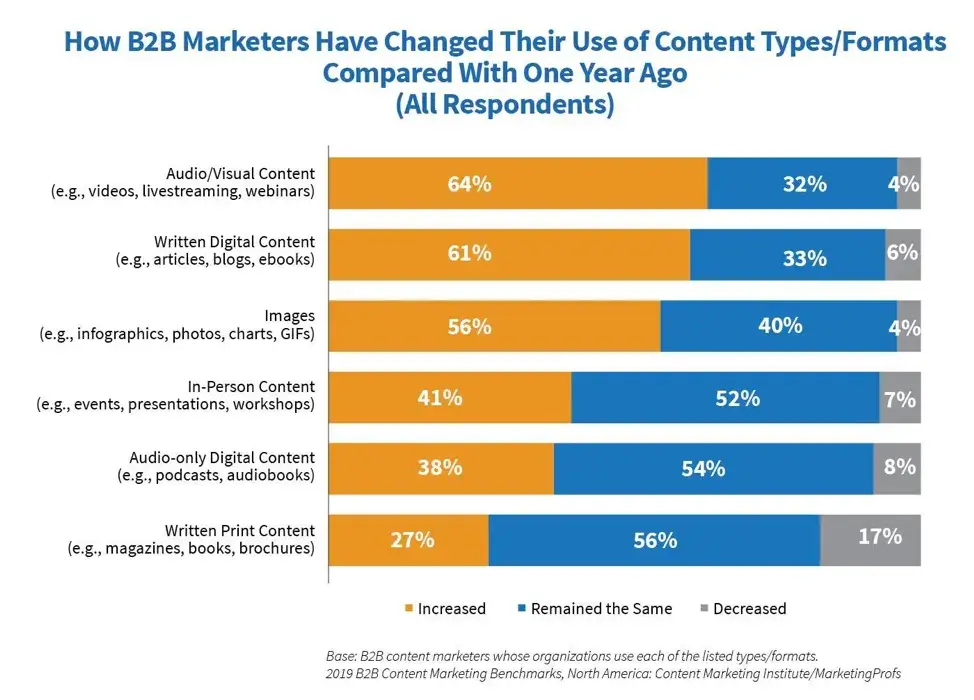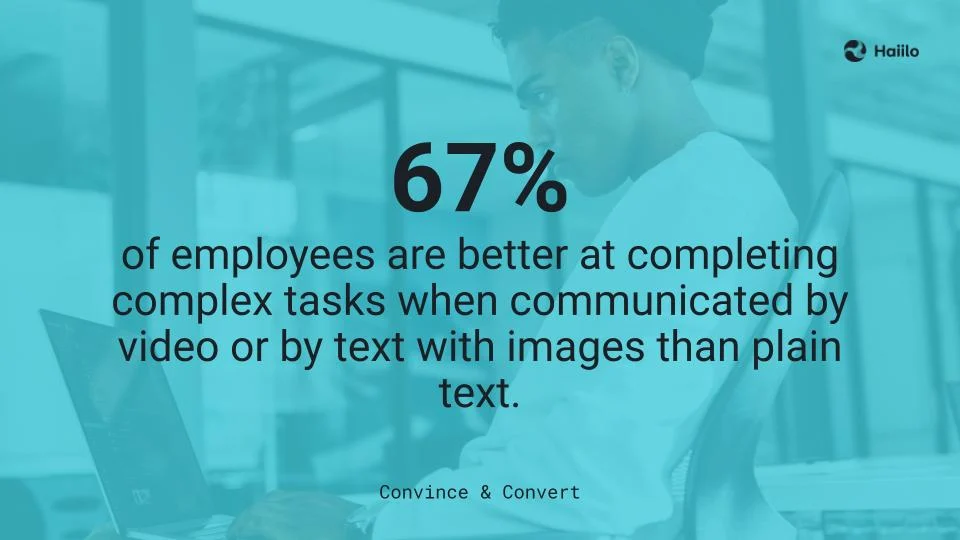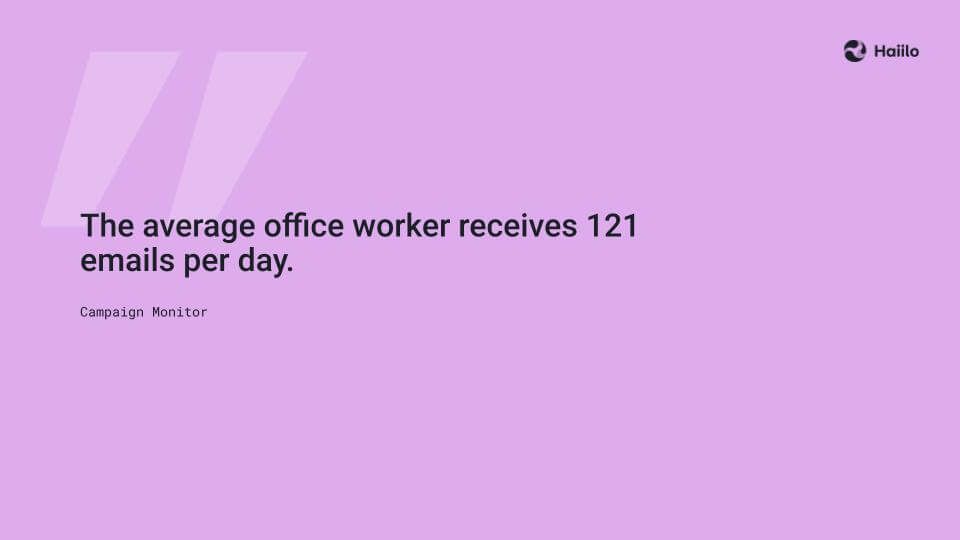Feel like internal communication in your business could do with an upgrade? Here are 8 ways you can use video to level up.
Video marketing has become one of the top three mediums that businesses are using today. Marketers now produce more video than a year ago, with some having ramped up their video production by as much as 64%.

Source: Content Marketing Institute
While video is great for outbound marketing, it’s just as a valuable tool for internal communication.
📚Download our ebook “How to Boost Internal Communication” where we share tips and tricks to build a successful internal communication.
After all, your workforce is made of people who enjoy watching videos. And yes, while most people may watch cat videos or their favorite YouTuber in their free time, things are changing!
In a recent research by Renderforest, 97% of respondents said that videos help them understand the business. Another study showed that 75% of executives watch work-related videos at least on a weekly basis.

Together, these stats prove that business-related content is actually consumed by professionals.
But how do you leverage video for internal communication?
Internal marketing is defined as the process of promoting a company’s goals, products, and services within the organization. This involves internal communication and education among other important aspects.
Because video is such a powerful tool, it’s ideal for helping businesses effectively reach their staff with timely messaging.
In this blog post, we share 8 ways to leverage video to help boost your internal communication.
We’ll look at how video can have a positive impact on employee onboarding, how it can be used as a tool for the timely distribution of important information, and why it’s ultimately essential for developing a growth-focused culture.
1. Take Your Employee Onboarding to the Next Level with Effective Internal Communication
Being a new starter is both exciting and nerve-wracking. There are new names and faces to commit to memory, and loads of information to absorb. Onboarding is meant to adequately address the needs of all new employees, but it can fall short.
In fact, while onboarding is essential for employee retention, companies lose as much as 25% of their staff within the first 12 months.
Many different reasons can encourage employees to leave the business within their first year at the company and poor internal communication is one of them.
Internal communication is essential when it comes to welcoming and onboarding new hires. But onboarding new hires doesn’t mean sharing a welcome kit, documentation, HR forms or safety rules. Instead, onboarding new hires consists of connecting new hires with their colleagues and inspiring them to contribute to the business’s success.
The first weeks at the company are critical and they have a great impact on the new hires’ motivation to stay at the company.

Video can be used as an on-demand solution for new starters. With access to online employee training on everything from internal policies to product training, ramping-up staff becomes easier.
The cost to a company also decreases considerably. Where you had to employ an in-house trainer, video becomes the 24/7 tool that lowers your overhead.
But most importantly, videos make employee onboarding more fun! It’s a great way for them to get familiar with the company’s culture and the information they need to get started with their job.
You can also encourage new hires to introduce themselves to their colleagues in a short video they would post to your employee communications platform where employees can easily comment on these intro videos. It’s a great way to break the ice and connect new hires with their colleagues!
2. Re-board Old Staff
Re-boarding is the retraining of staff. It’s an important part of keeping a team aligned with business objectives and updated with new product and/or service enhancements.
Re-boarding is also an important employee engagement and retention factor. Gallup research shows that millennials want jobs to be development opportunities. And that’s an important point to note.
Today, as much as 49% of the US workforce consists of millennials who are open to seeking opportunities elsewhere if they are not happy with their current job.
Video, once again, is the antidote. It can be used to deliver on-demand education, providing ambitious staff with all they need to grow.
3. Educate Employees Quickly
On-demand video isn’t just easily accessible, it can help you educate large groups of people in faster than in-person alternatives.
Because on-demand video can be delivered to many employees at the same time, you’re able to share new content faster and speed-up the education process in your organization.
Educational videos can range from lengthy tutorials to quick how-tos designed to help staff effectively complete mission-critical tasks while eliminating the risk and cost of errors, and in less time.
4. Simplify Complex Information
As technology evolves, it also introduces new challenges, most of which are complex. The complexity of the internal tool you use can cause bottlenecks, especially if your staff don’t know where to find the information they need.

Video marketing is a great way to address these and other complex education-related issues your organization may be facing.
For example, many organizations are adopting AI, machine learning and business analytics tools to uncover insights. These tools, however, are only helpful if staff know how to use them to dig deeper into data.
Related: Internal Communication: Definition, Challenges and Top Reasons Why It’s More Important than Ever
Creating internal videos on how to read, understand and act on data becomes critical for all stakeholders.
What’s more, approximately 65% of the population are visual learners, so it’s likely most of your employees are visual learners as well. That means you need to adapt your internal communication to your employees’ habits and ways of working.
5. Keep Employees Updated with Company News
There’s no shortage of information available today. From the collection of stats and analytics produced internally by businesses to the emails shared in and between departments. And while information is great to have, it can be overwhelming.

Video can serve as the perfect medium for sharing company news, updates or managing a PR crisis. And your video doesn’t have not be sophisticated either.
You can make a good video from the comfort of your desk and distribute it to your entire organization in minutes.
In fact, this level of agility is essential. It’s a competitive advantage for high-growth organizations in rapidly evolving industries.
Video, therefore, becomes a vehicle for delivering timely and valuable information to your employees.
Think about it: your employees may not have the time to read long reports. However, it’s easy for them to watch a short video on the go where their team leader shares highlights on the team’s performance or where top management shares updates on the business.
6. Connect Employees in an Authentic and Human Way
Employee engagement is a serious challenge for businesses across the globe. As much as 85% of staff are not engaged in the workplace.
While training is a key engagement factor, many employees cite relationships with managers and internal communication as factors that directly influence how engaged they feel.
Using video to bridge the divide, especially in a fast-paced organization, can help increase employee engagement.
With regular updates via video, leaders are able to provide mission-critical information that staff needs in a timely fashion. This also saves organizations from having to down tools to meet in a conference room whenever new information is available.
Video also helps build relationships. It serves as a medium for direct contact with each staff member. This, in turn, helps create line-of-sight for staff. They will be able to keep up with organizational updates and how their contributions, directly and indirectly, influence the business.
7. Encourage Your Employees to Play an Active Role in Your Internal Communication
Encouraging staff to become video creators can accelerate the growth of a more inclusive and empowered organization.
Team members can begin to contribute by becoming video creators and use video in various ways.
As explained earlier, introductory videos featuring new staff can help new starters quickly develop strong relationships with their colleagues. Likewise, knowledge sharing tips (think best practices or updates about what’s going on in a specific market segment) can also become regular video features to keep all departments updated and aligned with the business.
The key here is it make video production as easy as possible for your employees.
Keep in mind that not all of them are motion designers or video producers! Provide your employees with a content booster that will help them produce and share their videos — no matter what their video technical skills are.
8. Boost Your Company Culture
Company culture isn’t born in a day. It’s cultivated over time. In many ways, it’s the culmination of a set of values that leadership and staff exemplify. Using video as a method of supporting your culture is possible.
To capitalize on video, you’ll need to introduce it as a medium that all staff can use. Video needs to be seen as more than just an internal communication tool. It must be considered as the way that your staff engage with each other and share knowledge.
Related: Company Values: Definition, Importance and Examples
Like all new endeavors, using video won’t become an overnight practice. It will take time for people to warm-up to the idea. But once they’ll get started with it, it’ll be way easier for them to connect with their colleagues!
If you’re in a leadership role and wondering how to introduce video as a real and viable communication tool, here are 3 tips on how to promote it internally:
- Educate on the value of video. As shown above, video is a powerful tool. But for it to be used, you’ll have to educate staff on the value it brings as an internal communication and knowledge-sharing medium.
- Provide a basic policy for the creation of content. To make the use and creation of video a norm, you’ll need to introduce a set of rules that align with your business’ culture. These can include anything from the types of videos that can be created to more strict rules about the type of language employees can use in videos.
- Use a mobile-first employee communications platform. Ideally, you should have a platform that will help you centralize all your content. We call it the content booster at Haiilo. This is where all staff will go to keep up with the latest announcements and get access to educational content such as training courses, office guidelines, tutorials, demos, employee testimonials and so on. Using this kind of platform is also a great way for you to drive adoption and improve employee engagement as your employees can react to the videos you’ve or your colleagues have created!
Conclusion
Video is a must for all brands. It the perfect tool for telling stories and engaging buyers. It’s also the quintessential component for creating a great internal communication. Using on-demand video, companies can empower their staff through easily accessible educational content. Video also helps brands improve employee training and create an engaged workforce.









